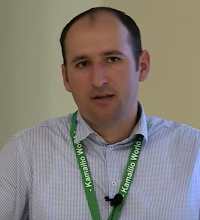The participation of Kamailio at LinuxTag
this year was filled with several related events and, as usually, a
great opportunity for community meeting and social networking.
Again, five of the management team members were at the booth in various occasions, answering questions and making demos: Andreas, Carsten, Daniel, Henning and Ramona. Marius and Mario from 1 & 1 Romanian branch and Germany completed our staff. We shared the space with related SEMS project, Stefan, Rafael, Vladimir and Alena being there for it.
On Wednesday, Carsten had his presentation in the LinuxTag Conference track, Daniel did the Project Fast Forward presentation at Open Source Arena. On Thursday, Daniel gave one hour workshop about how to install Kamailio and configure it for secure unified communication services – a well received event, the seminar room being fully attended. On Saturday, the Project Fast Forward presentation was repeated by Daniel. Links to presentations:
We learned about interesting deployments using Kamailio, notable being a relatively large Instant Messaging and Presence communication platform, using the SIP SIMPLE presence modules (including RLS) – the average online user base being 40 000, with peaks at 60 000. Out there are much more larger Kamailio deployments, but mainly targeting telephony services. This deployment proves that SIP SIMPLE presence extensions are becoming more and more an attraction, not being a dead direction. Our upcoming Kamailio v3.3.0 has a lot of improvements in scalability of presence related modules, which along embedded XCAP server and MSRP relay modules, makes Kamailio the most complete SIP SIMPLE implementation out there.
Now LinuxTag 2012 is gone, time to focus on the release of Kamailio v3.3.0!
Again, five of the management team members were at the booth in various occasions, answering questions and making demos: Andreas, Carsten, Daniel, Henning and Ramona. Marius and Mario from 1 & 1 Romanian branch and Germany completed our staff. We shared the space with related SEMS project, Stefan, Rafael, Vladimir and Alena being there for it.
On Wednesday, Carsten had his presentation in the LinuxTag Conference track, Daniel did the Project Fast Forward presentation at Open Source Arena. On Thursday, Daniel gave one hour workshop about how to install Kamailio and configure it for secure unified communication services – a well received event, the seminar room being fully attended. On Saturday, the Project Fast Forward presentation was repeated by Daniel. Links to presentations:
- Kamailio Project Fast Track Presentation
- Kamailio Workshop – Secure UC Services
- Carsten’s presentation on Kamailio, IMS and Rich Communications
We learned about interesting deployments using Kamailio, notable being a relatively large Instant Messaging and Presence communication platform, using the SIP SIMPLE presence modules (including RLS) – the average online user base being 40 000, with peaks at 60 000. Out there are much more larger Kamailio deployments, but mainly targeting telephony services. This deployment proves that SIP SIMPLE presence extensions are becoming more and more an attraction, not being a dead direction. Our upcoming Kamailio v3.3.0 has a lot of improvements in scalability of presence related modules, which along embedded XCAP server and MSRP relay modules, makes Kamailio the most complete SIP SIMPLE implementation out there.
Now LinuxTag 2012 is gone, time to focus on the release of Kamailio v3.3.0!



